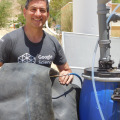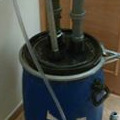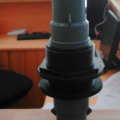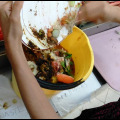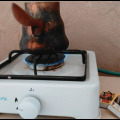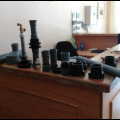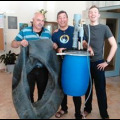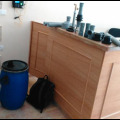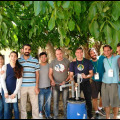[[{"fid":"1562","view_mode":"content_medium","fields":{"format":"content_medium","field_file_image_alt_text[und][0][value]":"T.H. Culhane, co-founder of Solar CITIES, at Arava Institute in Israel with Pickel Barrel Biodigester","field_file_image_title_text[und][0][value]":"T.H. Culhane, co-founder of Solar CITIES, at Arava Institute in Israel with Pickel Barrel Biodigester","field_folder[und]":"123"},"type":"media","attributes":{"alt":"T.H. Culhane, co-founder of Solar CITIES, at Arava Institute in Israel with Pickel Barrel Biodigester","title":"T.H. Culhane, co-founder of Solar CITIES, at Arava Institute in Israel with Pickel Barrel Biodigester","height":"251","width":"400","class":"media-element file-content-medium"}}]]
Making a Solar CITIES Pickle Barrel Biodigester is simple and effective and can be done in a short workshop of about an hour, so it is ideal for classrooms and conferences. It provides a hands on STEM Science experience and can be done for the most part with easy to obtain local plumbing parts and the only tool required is a knife. A Home Depot or paint bucket with water tight lid can substitute for the pickle barrel. We did this workshop in Beit Jala in Palestine on May 18 2016, so the photos and the parts are appropriate for this region of the middle east.
The most difficult things to obtain to do the build are the bulkhead fittings. One can use local rubber gasket uniseals (they sell them in plumbing shops in Ramallah for 50mm pipes) but then you need a precise hole saw or heated metal pipe to get the circumference of the hole you make perfectly smooth and accurate. With a bulkhead fitting, which has a locking nut that squeezes a flat rubber washer ring, you have some room for error, which is why you can use a knife to cut the hole.
The bulkhead fittings we used are the 2 inch threaded variety that can be obtained for a great price (under $6 each!) from Uniseal Warehouse at http://Aussieglobe.com. The precise URL for ordering them from Keith Beranek (he knows all about our project if you need to speak to someone directly who can help) is http://www.aussieglobe.com/Bulkhead-ABS-Thread-x-Thread--2-inch_p_51.html
[[{"fid":"1561","view_mode":"content_medium","fields":{"format":"content_medium","field_file_image_alt_text[und][0][value]":"2 inch threaded bulkhead fitting; you'll need three","field_file_image_title_text[und][0][value]":"2 inch threaded bulkhead fitting; you'll need three","field_folder[und]":"123"},"type":"media","attributes":{"alt":"2 inch threaded bulkhead fitting; you'll need three","title":"2 inch threaded bulkhead fitting; you'll need three","height":"199","width":"400","class":"media-element file-content-medium"}}]]
You can use smaller bulkhead fittings (particularly for the gas out and the slurry out) but we like to use all 2 inch fittings for a couple of reasons:
1) The minimum feedpipe size that is practical without getting clogs is 2 inches.
2) If you balance the feedpipe size and the slurry out size you won't get any embarressing back up spills if you feed to quickly (i.e. every liter of food waste you put in will give you a liter of slurry out immediately). This also means you don't have to make the feed in pipe too much higher than the slurry out pipe.
3) If the gas out pipe is 2 inches at first, and reduces to half inch only when it gets up above the slurry out pipe, you don't have to worry about the gas out pipe clogging up with residual manure or straw bits or other floaties; the gas will emerge above the 2 inch water line and only then encounter the reduction to half inch.
That said, you could, if need be, use a half inch bulkhead fitting for the gas out directly. Still, the nice thing about using all 2 inch fittings and pipes is that you can then easily migrate to a larger system, simply substituting the pickle barrel (which is about 40 liters) with a 200 liter barrel or a 1000 liter IBC tank without buying anything else except a coupler and some longer 2 inch pipe sections to reach to the bottom of the new tank.
In other words, you can practice your build on a pickle barrel or paint bucket and then use the same bulkhead fittings and top pipe plumbing parts for any larger system. This lets you grow with your dragon!
So that is the basic idea between Solar CITIES' field tested paint bucket and pickle barrel and 55 gallon drum (200 liter barrel ) systems -- ideal for school and home projects to get you into the game of biogas so you can then move up to larger systems as your desire grows. The small mini systems are effective (producing 1 to 3 to 5 to 10 minutes of gas a day (enough to cook an egg or make a cup of tea). The IBC tank made from 1000 liter tanks, can give you up to 2 hours of cooking a day. The rule of thumb is that every 100 liters of biodigester volume gives you approximately 100 liters of uncompressed gas under ideal conditions (35 C and pH of 7, fed 1/40th the volume of the digester) and 100 liters of uncompressed biogas gives you approximately 15 minutes of cooking on a single burner with a medium flame.
In practicality you may get half that, since most areas can be more easily kept at 25 C. But this still means that you can get about 3 minutes a day from a pickle barrel digester (figuring that the barrel is 40 liters and should be fed 1/40 its volume (1 liter) per day of food waste and that it can produce a maximum of 40 liters of uncompressed gas but that it is more likely to produce 20 liters per day. 20 liters, being one fifth of 100, should give 1/5th of 15 minutes, which is enough for a 3 minute egg!).
Here is how you build it:
You need the following parts from the local plumbing or agricultural shop:
The stomach of the dragon:
- 1 40 liter pickle barrel with lid (make sure the lid has a rubber o-ring inside for watertight seal and that it has the metal clamping ring to keep it sealed!).
The gas holder:
- 1 large truck tire inner tube (de-core the gas inlet valve so there is no restriction to the gas going in).
- 1 approximately 20 foot length of clear 1/2 inch PVC rubber tubing (to get the gas from the barrel to the inner tube)
- 1 approximately 3 foot length of rubber hose that fits over the inner tube valve and fits inside the clear tubing so you can connect them.
- Two hose clamps
The mouth and throat of the dragon (feed pipe) and the ureter (slurry fertilizer out pipe):
[[{"fid":"1567","view_mode":"content_medium","fields":{"format":"content_medium","field_file_image_alt_text[und][0][value]":"","field_file_image_title_text[und][0][value]":"","field_folder[und]":"123"},"type":"media","attributes":{"height":"711","width":"400","class":"media-element file-content-medium"}}]]
[[{"fid":"1568","view_mode":"content_medium","fields":{"format":"content_medium","field_file_image_alt_text[und][0][value]":"This photo shows the 50 mm pipe adapters you can find in Palestine that screw into the 2 inch bulkhead fitting top and bottom. Ignore the rubber ring uniseals and white 1/2 inch bulkhead as they weren't used in this build but were there for demonstration.","field_file_image_title_text[und][0][value]":"This photo shows the 50 mm pipe adapters you can find in Palestine that screw into the 2 inch bulkhead fitting top and bottom. Ignore the rubber ring uniseals and white 1/2 inch bulkhead as they weren't used in this build but were there for demonstration.","field_folder[und]":"123"},"type":"media","attributes":{"alt":"This photo shows the 50 mm pipe adapters you can find in Palestine that screw into the 2 inch bulkhead fitting top and bottom. Ignore the rubber ring uniseals and white 1/2 inch bulkhead as they weren't used in this build but were there for demonstration.","title":"This photo shows the 50 mm pipe adapters you can find in Palestine that screw into the 2 inch bulkhead fitting top and bottom. Ignore the rubber ring uniseals and white 1/2 inch bulkhead as they weren't used in this build but were there for demonstration.","height":"711","width":"400","class":"media-element file-content-medium"}}]]
- 4 50 mm threaded pipe adapters to screw into the 2" bulk head fittings and connect the 50 mm pipes. You will use two for each of the bulkheads used for the feed pipe and the slurry pipe.
- 1 4 inch to 50 mm adapter (this is used as a funnel like mouth to pour food into the throat).
- 1 50 mm T for the slurry out pipe (enables user to unblock slurry pipe with a stick and prevents siphoning).
- 1 50 mm elbow for slurry out pipe
- 4 meters of 50 mm pipe (some, in lengths of about 10 to 15 inches, is used to connect the funnel to the throat pipe adapter, some to connect the elbow to the T and the T to the pipe adapter, and some, about a half a meter or so, depending on the depth of your pickle barrel, is used to extend to the bottom of the barrel from the feed pipe and to the bottom of the barrel from the slurry out pipe.)
The gas out pipe
- Two inch male threaded to one inch reducer.
- 1 inch threaded nipple (pipe), approximately 15 cm long.
- 1 inch to 1/2 inch reducer
- half inch valve
- half inch elbow
- half inch barbed hose connector fitting (to connect gas hose)
NOTE THAT MANY OTHER PARTS CAN BE SUBSTITUTED AS LONG AS THEY SERVE THE SAME SIMPLE FUNCTIONS: FOOD HAS TO GET IN THE TANK TO THE BOTTOM, SLURRY HAS TO COME OUT OF THE TANK FROM THE MIDDLE AND GAS NEEDS TO GET OUT OF THE TANK FROM THE TOP. That's essentially it! By going in from the top of our tanks we realized we don't need to damage the tank and we get good gas pressure.
If you want a more useful system you can simply substitute an IBC tank for the pickle barrel and just make the feed and slurry pipes a bit longer. Everything else is the same!! The IBC will give you two hours of cooking a day; the pickle barrel 3 to 5 minutes.
How to build the digester:
- Place the bulkhead fittings on the lid of the barrel and draw the circumference of the threaded part with a sharpee marker.
- Very very carefully cut the holes into which you will insert the bulkhead fittings with a sharp knife. Make sure you do not nick or cut the hold outside of its internal circumference. Try to make the cut as round and smooth as possible and scrape off or sand any burrs. You want the surface of the lid where the bulkhead fitting rubber gasket sits to be as smooth and possible.
- Put the bulkhead fitting in from the bottom of the lid with the rubber gasket on the INSIDE. Use silicone plumbers goop or axle grease if you have it. It really helps ensure the seal.
- Screw down the locking nut. Use grease or silicone on both top and bottom before you screw the locking nut down.
- Designate one of the bulkheads as the feeding in pipe (it helps to write on the lid) and one of the them the slurry out pipe.
- Screw in the 50 mm fittings on the top and bottom of both the feeding bulkhead and the slurry out bulkhead so you have the ability to connect pipes to them.
- Cut two lengths of pipe long enough to reach the bottom of the barrel from both of the 50 mm fittings. Cut an angle off of the bottom of the feed pipe and so food can slide in the bottom of the barrel and not get stuck. Cut a hole in the center of the slurry out pipe so that the digested liquid that concentrates in the center of the tank can come out (the extra length of pipe extending to the bottom of the tank acts as more surface area for bacteria to form biofilms).
- Fix the pipe lengths to the bulkhead fittings bottoms and check that they reach the bottom of the tank but don't prevent the lid from closing.
- Cut one length of pipe about 15 cm and connect it to the top bulkhead pipe fitting of the feeding pipe. Afix the 4 inch to 50 mm "funnel" adapter to this pipe. You are done with the feeding pipe.
- Cut one length of pipe about 10 cm (at least 5 cm shorter than the feeding pipe) and attach to the fitting of the slurry out pipe. Afix the T to this pipe so that it looks like a straigh pipe with a hole coming out the side.
- Cut one length of pipe about 10 cm and afix it to the hole of the T coming out horitally.
- Afix the elbow to the pipe coming out of the T with the elbow facing down. This is the slurry overspill.
- Attach another length of pipe to this elbow long enough to go into a fertilizer slurry bucket. This is where your fertilizer will come out each day when you feed the digester.
- Attach the 2 inch threaded to 1 inch adapter to the TOP of the remaining bulkhead. This bulkhead has NO pipes or adapters on the inside of the barrel because we want the gas, which rises, to be able to escape from here.
- Attach the 1 inch pipe, which should be taller than the slurry out pipe.
- Attach teh 1 inch to half inch reducer
- Attach the 1/2 inch valve (it can be a water valve since biogas is under no pressure).
- Attach the 1/2 inch elbow
- Attach the 1/2 inch barbed hose connecter.
- Attach the 1/2 inch clear plastic hose.
- Place the truck or tractor tire inner tube next to the digester in a protected area (so it doesn't get damaged by sun or animals) and make sure the core has been removed (so gas can freely flow in and out).
- Attach a hose piece that fits on the gas in pipe of the inner tube and clamp it. Connect this hose to the 1/2 inch hose (you may have to shave it down a bit with a knife to insert one pipe in the other).
Finally, fill your pickle barrel with 10 or 20 kg of cow or horse or other manure or innoculant and then fill up with water and plastic water bottles that have holes cut in them so they sink. Throw bits of plastic in the digester. You can also add gravel to the bottom. You want to increase surface area. Pistachio shells and olive pits are good surface area material for the digester too. So are plastic brushes. If you have another active biodigester nearby, as we did, fill up with as much slurry from that digester as possible (then you will get gas in 24 hours rather than the usual three weeks or so needed to ferment the fresh dung).
Do not feed until you get first blue flame of flammable biogas.
Thereafter feed ONLY a maximum of 1 liter of food waste per day so it doesn't go acid (you can feed less, you just won't get much gas. You can let it go days or weeks without feeding too!). You don't need to add any more animal manures, but you are welcome to.
Keep in a warm place and feed with warm water and you should get up to 40 liters of gas per day (meaning you might be able to feed the inner tube each day). Results will vary. We look forward to hearing yours at
https://www.facebook.com/groups/methanogens/
Put pictures and a description and a location of your biodigester on http://biogascentral.net.
Enjoy and spread the word!
See pictures below for a better idea of how this simple digester is built, and watch our very silly but almost comprehensive explanatory video (silly because I am using a pseudo 19th century British colonialist voice for fun) here:
[[{"fid":"1563","view_mode":"wysiwyg","fields":{"format":"wysiwyg","field_folder[und]":"123"},"type":"media","link_text":"Pickle barrel biodigester in Palestine near Bethlehem.","attributes":{"class":"file media-element file-wysiwyg"}}]]
[[{"fid":"1564","view_mode":"wysiwyg","fields":{"format":"wysiwyg","field_folder[und]":"123"},"type":"media","link_text":"First flame from pickle barrel biodigester at Arava","attributes":{"class":"file media-element file-wysiwyg"}}]]
[[{"fid":"1575","view_mode":"wysiwyg","fields":{"format":"wysiwyg","field_folder[und]":"123"},"type":"media","attributes":{"class":"file media-element file-wysiwyg"},"link_text":"Demonstrating Solar CITIES Pickle Barrel Biodigester to Nigerian friend Smart Chukwuma Amaefula"}]]


